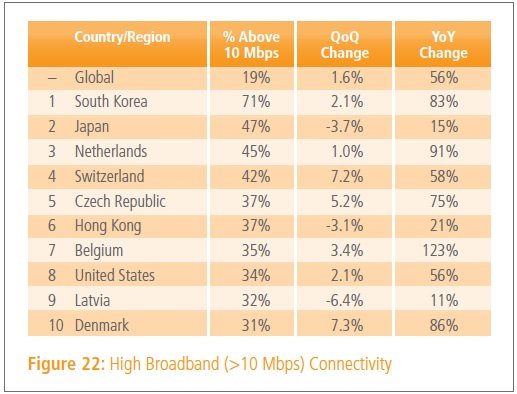US Moves Up in Akamai Rankings
The latest State of the Internet Report from Akamai shows continued improvement in Internet speeds in the United States, with Top 10 rankings in all three performance metrics, Average Connection Speed, Average Peak Connection Speed, and High-speed Broadband Connectivity. This belies the claim that so many ill-informed critics make that the US is “falling behind” other countries.
Average Connection Speed measures how fast web browsers pull down content on each of the four to eight TCP connections they run in parallel while loading web pages. The US ranks 10th in this metric, with a 2.0% increase over the previous quarter. If that doesn’t sound like a great improvement, consider the fact that five of the top 10 showed declining speeds.
Average Peak Connection Speed is the best measure of broadband capacity because it’s not affected by the design of applications like Average Connection Speed is. The US moved up to 10th in this ranking, with average broadband capacity of 43.7 Mbps. This measurement includes business connections as well as residential ones. Business connections are more important for economic growth than residential connections are, as people tend to use the Internet more for entertainment than for productivity at home, but the pattern is reversed at work.
Finally, High Speed Broadband Connectivity tells us how widely dispersed high-end broadband packages are in actual use. The US maintains its Top 10 ranking at number eight. Now 34% of Americans are actually using high speed broadband, with TCP speeds of 10 Mbps or better.
This is NOT what “falling behind” looks like.
- Average connection speeds are rising in the US while they’re falling in five of the Top 10, including the darlings of American broadband critics: South Korea, Japan, Hong Kong, Netherlands, and Latvia.
- The nations with the most dramatic increases in overall broadband capacity are nations we don’t hear that much about in the American press: Singapore, Taiwan, and, yes, the United States.
- An amazing thing is happening in Japan, Hong Kong, and Latvia: despite the prevalence of super-fast, all-fiber networks, there is actually a decrease in the percentage of users with the fastest connections, those greater than 10 Mbps for browsing. I suspect that this is driven by the movement of young people away from fiber and all-in for wireless in Japan and Hong Kong, but in Latvia I would ascribe it to network congestion. That’s speculation, however, as it’s not improbable that Latvian youth are investing all their broadband dollars on mobile.
I doubt we’ll hear much about Latvia’s decline from the journalists who happily compared Riga to San Antonio, Texas a few months ago, but you never know.
Updated April 23, 11:48 PM.






